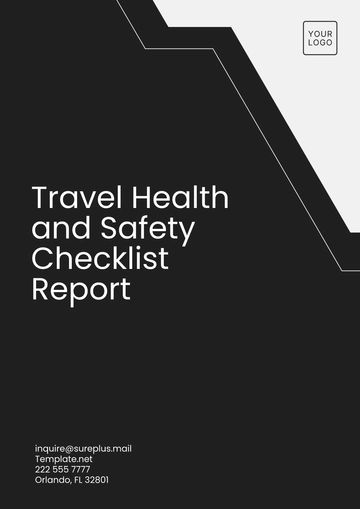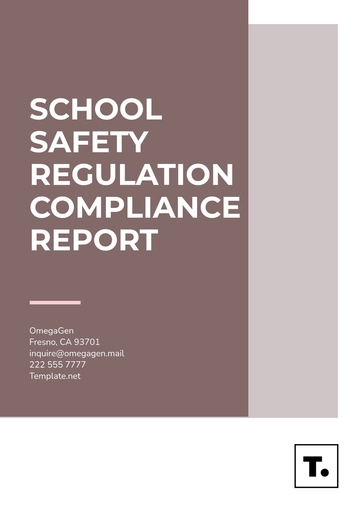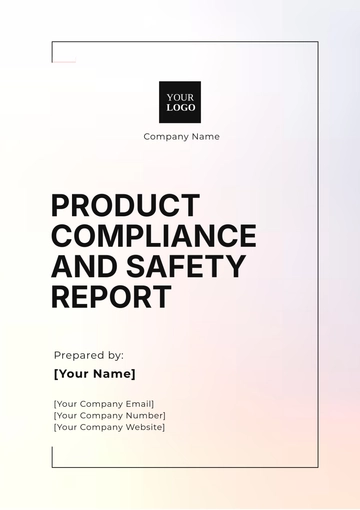Free Professional Safety Report

Prepared by: [Your Name]
I. Introduction to Safety
Ensuring professional safety within the workplace is a critical responsibility of organizations. The objective of this report is to outline key areas of concern, discuss safety standards, and propose effective strategies to foster a safer working environment.
II. Understanding Safety Standards
1. International Safety Standards
International safety standards are crucial in establishing a unified approach towards minimizing workplace hazards. These standards provide organizations with the guidelines needed to protect employees and reduce incidents of injury.
Standard | Description |
|---|---|
ISO 45001 | Specifies requirements for an occupational health and safety (OH&S) management system. |
OHSAS 18001 | Framework for an OH&S management system, allowing for better risk management. |
2. National Safety Regulations
In addition to international standards, national regulations play a pivotal role in workplace safety. These regulations are tailored to address local safety concerns and ensure compliance within specific industries.
III. Safety Management Practices
1. Hazard Identification and Risk Assessment
Effective safety management begins with identifying potential hazards and assessing associated risks. This involves systematic procedures to document and analyze every aspect of operations.
Conducting workplace inspections
Utilizing risk assessment tools
Regularly updating hazard logs
2. Implementation of Safety Programs
Safety programs are essential for educating employees and instituting preventive measures. These programs integrate safety procedures into everyday work practices.
Training sessions and workshops
Emergency response drills
Continuous safety monitoring and evaluation
IV. The Role of Technology in Safety
1. Safety Monitoring Systems
Technology plays an indispensable role in enhancing workplace safety. Safety monitoring systems provide real-time data and alerts, ensuring that potential risks are promptly addressed.
2. Incident Reporting Tools
Incident reporting tools assist in documenting safety breaches and allow for comprehensive analysis to prevent recurrence. They provide a streamlined approach for tracking incidents, actions taken, and outcomes.
V. Conclusion and Recommendations
In conclusion, maintaining professional safety requires a multifaceted approach that incorporates international standards, national regulations, and advanced safety management practices. Organizations must strive to create a culture of safety that leverages technology and fosters continuous improvement.
Recommendations for enhancing professional safety include:
Regular safety audits and evaluations
Increased investment in safety technology
Enhanced training programs that focus on proactive safety management
- 100% Customizable, free editor
- Access 1 Million+ Templates, photo’s & graphics
- Download or share as a template
- Click and replace photos, graphics, text, backgrounds
- Resize, crop, AI write & more
- Access advanced editor
Create thorough safety reports with ease using the Professional Safety Report Template from Template.net. Fully editable and customizable, this template allows you to tailor each section to your needs. Enhance your reporting process with the AI Editable Tool, ensuring accurate, professional, and efficient safety documentation for any industry or workplace.
You may also like
- Sales Report
- Daily Report
- Project Report
- Business Report
- Weekly Report
- Incident Report
- Annual Report
- Report Layout
- Report Design
- Progress Report
- Marketing Report
- Company Report
- Monthly Report
- Audit Report
- Status Report
- School Report
- Reports Hr
- Management Report
- Project Status Report
- Handover Report
- Health And Safety Report
- Restaurant Report
- Construction Report
- Research Report
- Evaluation Report
- Investigation Report
- Employee Report
- Advertising Report
- Weekly Status Report
- Project Management Report
- Finance Report
- Service Report
- Technical Report
- Meeting Report
- Quarterly Report
- Inspection Report
- Medical Report
- Test Report
- Summary Report
- Inventory Report
- Valuation Report
- Operations Report
- Payroll Report
- Training Report
- Job Report
- Case Report
- Performance Report
- Board Report
- Internal Audit Report
- Student Report
- Monthly Management Report
- Small Business Report
- Accident Report
- Call Center Report
- Activity Report
- IT and Software Report
- Internship Report
- Visit Report
- Product Report
- Book Report
- Property Report
- Recruitment Report
- University Report
- Event Report
- SEO Report
- Conference Report
- Narrative Report
- Nursing Home Report
- Preschool Report
- Call Report
- Customer Report
- Employee Incident Report
- Accomplishment Report
- Social Media Report
- Work From Home Report
- Security Report
- Damage Report
- Quality Report
- Internal Report
- Nurse Report
- Real Estate Report
- Hotel Report
- Equipment Report
- Credit Report
- Field Report
- Non Profit Report
- Maintenance Report
- News Report
- Survey Report
- Executive Report
- Law Firm Report
- Advertising Agency Report
- Interior Design Report
- Travel Agency Report
- Stock Report
- Salon Report
- Bug Report
- Workplace Report
- Action Report
- Investor Report
- Cleaning Services Report
- Consulting Report
- Freelancer Report
- Site Visit Report
- Trip Report
- Classroom Observation Report
- Vehicle Report
- Final Report
- Software Report





























